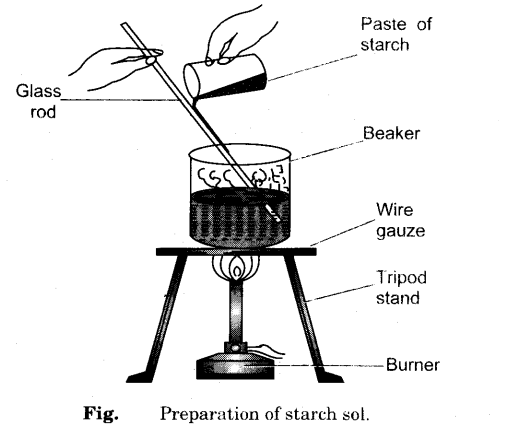Surface Chemistry: Lyophilic colloids
The nature of interactions between a dispersed phase and dispersion medium directs the colloidal solutions to be classified into two types as lyophilic and lyophobic sols.
Lyophilic colloids aresolvent loving(Lyo means solvent and philic means loving). These are the colloidal solutions, in which the particles of the dispersed phase have a great affinity for the dispersion medium. They are directly formed by substances like gum, gelatine rubber etc. on mixing with a suitable liquid(the dispersion medium).Gels are often formed by cooling lyophilic sols that contain large linear molecules andhave a much greater viscosity than the solvent.Lyophilic and association colloids are thermodynamically stable. Lyophilic sol can be easily made by a mixing colloid with the liquid solvent.
Stability is accomplished essentially by providing the dispersed particles with an electric charge and surrounding each particle with a protective solvent sheath which prevents mutual adherence when the particles bump as a result of Brownian movement. Likewise, small amounts of an electrolyte added to a lyophilic colloid in moderate amounts does not result in coagulation.
Colloids are spontaneously formed by dispersing the material in the solvent e.g. dispersion of acacia or gelatin in water (hydrophilic colloid) or nitrocellulose in alcohol ether (collodion).If the solvent is evaporated, the sol can be made again by simply re-mixing with solvent. These colloids don’t need stabilizing agents.The addition of some lyophilic colloids like gums, soaps, gelatin etc. to lyophobic colloids makes lyophobic colloids difficult to coagulate by addition of electrolytes. This process is identified as protection and lyophilic colloids are termed as protective colloids.
Examples:
Starch Sol
Starch can form lyophilic sol by using water as a dispersion medium. The formation of sol is accelerated by heating the medium, in this case, water at 100°C. It is quite stable and is not affected by the presence of any electrolytic impurity.

Fig : Preparation of starch sol.
Gum Sol
Similarly to starch, gum can also form lyophilic sol with water. Instead of boiling water, warm water is used for the preparation of sol because of the higher solubility of gum in water.
Egg Albumin Sol
Egg albumin is extracted from eggs forms a lyophilic sol with cold water. The sol is quite stable and is not affected bytraces of impurities present in the mixture.
Table : Lyophilic vs. lyophobic colloids.
| Property | Lyophilic sols (suspension) | Lyophobic sols (Emulsoid) |
| Surface tension | Lower than the medium | Same as that of the medium |
| Viscosity | Much higher than that of the medium | Same as that of the medium |
| Reversibility | Reversible | Irreversible |
| Stability | More stable | Less stable |
| Visibility | Particles can’t be detected even under ultramicroscope | Particles can be detected under ultramicroscope. |
| Migration | Particles may migrate in either direction or do not migrate in an electric field because do not carry any charge. | Particles migrate towards cathode or anode in an electric field as they carry a charge. |
| Action of electrolyte | Addition of smaller quantity of electrolyte has little effect | Coagulation takes place |
| Hydration | Extensive hydration takes place | No hydration |
| Examples | Gum, gelatin, starch, proteins, rubber etc. | Metals like Ag and Au, hydroxides like Al(OH3), Fe(OH)3 metal sulphides like AS2S3 etc. |
